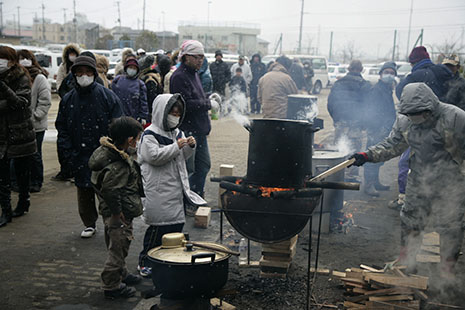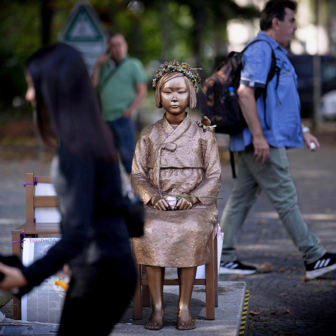“Crisis” is one of the most overused words in the media lexicon. Just over a week ago, the government of Japanese Prime Minister Naoto Kan was said to be facing its “greatest crisis” to date. The cause of this political furore was a string of resignations by ruling party politicians, most notably the foreign minister, who had been forced to step down after admitting to a minor breach of Japan’s campaign funding laws.
This week, months of bitter political feuding melted into utter irrelevance. “Crisis” suddenly took on a raw and shocking new meaning as the same government found itself struggling to deal with a cataclysm whose death toll is soaring into the tens of thousands and with the worst nuclear disaster since Chernobyl. Just as 11 September 2001, with its images of New York’s collapsing twin towers, has been seared into global memory, so 11 March 2011 will forever be associated with those seemingly impossible pictures of ships marooned on the roofs of houses, whole towns engulfed in a matter of minutes by the forces of nature, and explosions of smoke and steam billowing from nuclear power plants that were supposed to be disaster-proof.
Japan will, of course, survive this double catastrophe. Overwhelming though the task may seem, Japanese society will recover. But will it ever be the same again? How will the Japan of the future differ from the country pre-3/11?
The lessons of 1923 and 1995
No amount of experience or planning can prepare a society for a tragedy of this magnitude. But Japan has certainly had more experience than most, and history provides some indications of the likely impact of these events. The atomic bombings of Hiroshima and Nagasaki and the firebombing raids on other Japanese cities in 1945 were the greatest calamities modern Japan has faced. But two massive natural disasters – the Great Kanto Earthquake of 1923 and the Great Hanshin (Kobe) Earthquake of 1995 – offer the closest parallels to current events.
Though the magnitude of the 11 March earthquake is the greatest recorded in Japan’s modern history, its terrible death toll is still well below that of the great earthquake of 1923, which left over 100,000 people dead and around half a million injured. The 1923 quake struck around the middle of the day almost immediately under densely populated areas of Yokohama and Tokyo, toppling wooden houses on top of open cooking stoves, and creating firestorms that killed vast numbers.
Media reports on the current disaster often comment on the calm and stoicism of the Japanese population, and attribute this to Japanese traditions of obedience and social order. But it is worth recalling that the 1923 earthquake triggered a horrifying reaction. Responding to rumours of sabotage by foreigners in their midst, some sections of the panicking population turned on Tokyo’s Korean and Chinese minority communities in the days following the earthquake, killing some 6000 people.
Once the immediate terror had passed, however, the recovery from this disaster was astonishingly swift. Local communities and the national government worked together to re-plan their city, and within two years Tokyo had risen like a phoenix from the ashes, with broad new boulevards and earthquake-resistant modern buildings replacing many of the wooden structures that had proved so fatally flammable. Society, economy and culture recovered too. The first half of the 1920s in Japan is remembered today as an era of relative liberalism, openness and vibrant cultural development, in contrast to the darker days of 1930s militarism.
Until this month, Japan’s worst earthquake since 1923 had been the Great Hanshin Earthquake, which struck Kobe and the surrounding areas in January 1995. In Kobe approximately 6400 people died – many of them again trapped in fires triggered by the collapse of buildings and power lines. As in 1923, so too in 1995 the tragedy evoked extreme reactions in some quarters. The followers of the rapidly expanding religious sect Aum Shinrikyo were persuaded to believe that the earthquake was an apocalypse that would bring down the Japanese state and transform Japan into a theocracy run by their leader, Shoko Asahara. Two months later, with the prophecy showing few signs of becoming reality, Asahara and his followers decided to take matters into their own hands, and launched poison gas attacks on the Tokyo subway in an unsuccessful attempt to complete the work that (according to their strange beliefs) the Kobe earthquake had begun.
But in Kobe 1995, as in Tokyo 1923, new life also sprouted from the wastelands of destruction. The mid-1990s is now recognised as having been a turning point in the development of Japanese civil society, not least because of the multitude of new social movements and humanitarian NGOs that flourished in Kobe and the surrounding areas following the quake. When local and national authorities failed to provide the necessary help to displaced communities, ordinary people – many of them young people with no previous experience of social activism – took up the challenge, creating grassroots groups which still flourish today.
A fragile system
In 2011, the scale of the disaster is much larger than in 1995. And, even though the death toll is lower than that of 1923, the effects of the material destruction are likely to be deeper and more long-lasting. The Japan of today, far more than the Japan of 1923, depends on a complex technological network for survival. Japanese cities (particularly Tokyo) have become immensely intricate machines whose operation relies on the smooth running of a maze of roads, rail links, power grids and communications networks. Throughout much of the past half century, these machines have operated with astonishing smoothness and efficiency, but even before the latest earthquake, the signs of ageing infrastructure were starting to show. The rail and subway links on which Tokyo depends for daily life, for example, were losing their clockwork precision, and beginning to experience more frequent breakdowns and delays.
Now the earthquake has thrown the entire system into chaos, mercilessly exposing the weaknesses in this highly centralised technological system. No amount of human ingenuity could possibly have prevented the tsunami from causing widespread death and destruction. But the failure of Fukushima No. 1 nuclear plant is another matter. There was something horribly predictable – indeed, long predicted – about this event.
As historian Elise Tipton writes, “for decades, Japanese in the Tokyo area have been anticipating an earthquake of major proportions such as that of 1923,” and many have been expressing concerns about the possibly lethal combination of large concentrations of nuclear power plants in such an earthquake-prone country. Tipton’s study of modern Japanese history, published three years ago, pointed out that “Tokyo Electric Power Company’s reluctance to admit damage to the world’s largest nuclear power station at Kashiwazaki-Kariya after the severe Niigata earthquake of July 2007 added to the credibility problems of nuclear power providers.” The same company runs the Fukushima No. 1 and No. 2 power plants, and many of the problems that Japan has faced in recent days stem from the company’s history of “crying sheep” (repeatedly issuing reassurances that later prove to be false – the opposite of “crying wolf”): most people have learnt to mistrust good news about nuclear accidents.
The events of the past week have left many Japanese people confused and angry at the conflicting reports they have received about their country’s latest and worst nuclear crisis. The nuclear disaster has diverted funds and energy from the desperately needed tusnami relief effort. Some 140,000 people living between twenty and thirty kilometres from the Fukushima No. 1 power plant have been ordered to remain in their homes to avoid the danger of radiation. But these homes have in many cases have been damaged by the earthquake and are without power. Food and water are rapidly running out, and the hapless citizens of this area feel that they have been abandoned to their fate by the authorities. Their concerns will hardly have been eased by news that the US military has ordered the withdrawal of all US forces to areas outside an eighty-kilometre radius of the stricken plant.
Damage to the now irreparable Fukushima Daiichi plant will affect Japan’s energy supply for months and possibly years to come. For now, all attention is focused on the desperate tasks of survival and rescue. But beneath the apparently calm surface, real anger is boiling towards explosion point. Once these immediate challenges of disaster relief have been overcome, there will have to be some serious apportioning of responsibilities.
Japan after 3/11
The 1923 Great Kanto Earthquake struck when Japan’s industrial development and imperial expansion were in full swing. Although the economy had suffered a brief downturn in the early 1920s, the national mood was generally positive and forward-looking. The 1995 quake came as Japan was moving from the economic “bubble” years of the 1980s into a prolonged period of economic stagnation. At that time, however, it was still possible to believe that stagnation would be short-lived. The mid 1990s was also a time of political dynamism in Japan. The Liberal Democratic Party had just lost their grip on power after forty years of uninterrupted rule, and there were hopes for a fairly radical overhaul of the political system (though these hopes ultimately proved unfounded).
The present disaster struck Japan when the country was in a general mood of despondency. The economy has been in the doldrums for two decades. Many people in Japan feel deeply unsettled by the rise of China, which recently overtook Japan to become the world’s second-largest economy. The Liberal Democratic Party, having regained its grip on the country’s political life in the 1990s, lost power to the opposition Democratic Party in 2009. But hopes that this would bring a new season of political reform proved shortlived. The Democratic Party government has been mired in scandals and shown no signs of being able to come to grips with the massive problems of the country’s ageing population and mounting debt. More fundamentally, neither side of politics has shown any ability to offer a persuasive new vision of Japan’s future.
This context will profoundly affect the way that the people of Japan respond to the current catastrophe. As I write, the nuclear crisis is still unfolding, and the death toll from the tsunami is still mounting. Decisive predictions about the future are impossible, but drawing on the experience of the past, some glimpses of Japan post-3/11 are possible.
The earthquake, tsunami and nuclear crisis have had a massive effect on the psyches of the people who experienced them, whether directly or indirectly through their effects on friends and relatives. In this sense, Japan will never be the same again. As with previous disasters, the response is unlikely to be simple or one-directional. Some people may take refuge in religious beliefs. For others, the response to the disaster may be a defensive sense of nationalism – not in the form of the murderous xenophobia of 1923, but in the form of an intensified inward-turning attitude and heightened fear of the outside world (particularly of the arch-rival, China).
However, as in the case of Kobe, it is also very possible that good will emerge from the debris of destruction. Once again, many Japanese people have found that the powers-that-be are helpless to save them – indeed, many are increasingly suspecting that the central authorities have let them down in their hour of need. All over Japan, ordinary people are performing extraordinary deeds as they search for lost friends and relatives, take care of displaced neighbours or provide assistance to those in need.
For the past two decades, Japan has been plagued by a sense of aimlessness. The grand visions of economic growth had lost their hold on the imagination, and many young people in particular found refuge from the ongoing malaise in cynical individualism. Now suddenly, through sheer force of circumstances, there are tasks to be done. Society matters once again.
The political effects may be considerable. The anger of the affected regions (particularly Fukushima Prefecture) towards the national authorities is already palpable. Ironically, though, the current government contains several people (including Prime Minister Kan himself) who have been long-term critics of Japan’s nuclear power industry. It is the opposition Liberal Democratic Party who were largely responsible for creating the system that has failed so badly.
This opens the possibility that the crisis may push the Japanese people finally to demand fundamental changes to the bureaucratic and party political system that has, until now, seemed so deeply entrenched and so incapable of confronting the country’s problems.
Kiki – the Japanese word for crisis – is closely related to the word kikai – opportunity. Once the immediate humanitarian issues are addressed, this disaster may indeed prove to be the stimulus for the fundamental political rethinking that Japan has long needed.
The challenge for the region
But if good is to come out of this tragedy, the support of Japan’s regional neighbours is absolutely essential. So far, the response has been encouraging. South Korea was one of the first to offer Japan assistance following the tsunami. China, itself no stranger to catastrophic earthquakes, has been swift and generous in its aid. Australia too has been quick to help a long-time regional friend.
This support will need to be sincere and sensitive to Japanese public sentiment. Any sense that China was in some way profiting from Japan’s disaster could be particularly dangerous in fanning the flames of potentially nationalist responses.
Natural disasters of this magnitude affect the entire surrounding region – indeed the entire world. This is not just Japan’s disaster. It is East Asia’s and the world’s disaster. In a globalised world, Japan is not inhabited only by Japanese. Some two million foreign residents in Japan, including hundreds of thousands of Chinese and Korean nationals and over 10,000 Australians, are also affected by 3/11. The problems of nuclear power exposed by the crisis are problems for the entire region as it struggles to deal with the issue of global warming. Closer cooperation could provide a key to developing better response systems for future disasters, which may strike any of the region’s countries at any time. A committed, long-term regional response to the events of past days will be the key to ensuring that both Japan and its region as a whole emerge stronger and more vigorous from the ruins of 3/11. •




